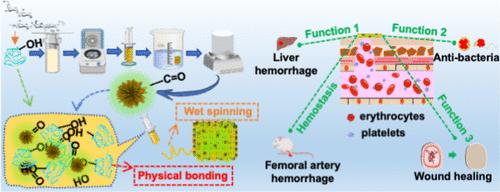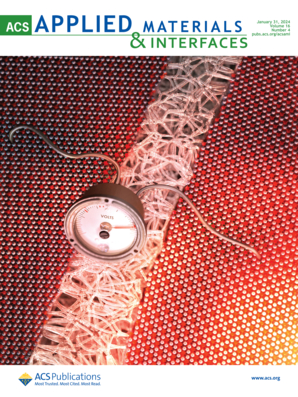Hemoadhican Fiber Composite with Carbon Dots for Treating Severe Hemorrhage and Infected Wounds
IF 8.3
2区 材料科学
Q1 MATERIALS SCIENCE, MULTIDISCIPLINARY
引用次数: 0
Abstract
Uncontrolled bleeding and infection following trauma continue to pose significant clinical challenges. This study employs hemoadhican (HD) polysaccharide, known for its superior hemostatic properties, as the foundational material to synthesize antibacterial carbon dots (H-CDs) through a hydrothermal method at various temperatures. The H-CDs exhibiting optimal antimicrobial properties were identified via in vitro antimicrobial characterization. The selected H-CDs possess nanoscale dimensions and a positive surface charge. They contain aldehyde groups and generate reactive oxygen species, which effectively eliminate bacteria. Subsequently, H-CDs were integrated into HD fibers (CDs-HD fibers) using a wet-spinning technique. The water vapor transmission rate, blood contact angle, and in vitro antimicrobial efficacy were evaluated. In a rat model of severe femoral artery hemorrhage and a noncompressible hepatic hemorrhage model, CDs-HD fibers demonstrated superior hemostatic performance compared to the commercially available QuikClot Combat Gauze. Furthermore, in a rat model of mixed bacterial wound infection, CDs-HD fibers significantly enhanced epithelial tissue remodeling and collagen deposition. In vivo studies confirmed the excellent biocompatibility of CDs-HD fibers. These findings suggest that CDs-HD fibers hold promise as a potential dressing for managing severe bleeding and preventing wound infections.

求助全文
约1分钟内获得全文
求助全文
来源期刊

ACS Applied Materials & Interfaces
工程技术-材料科学:综合
CiteScore
16.00
自引率
6.30%
发文量
4978
审稿时长
1.8 months
期刊介绍:
ACS Applied Materials & Interfaces is a leading interdisciplinary journal that brings together chemists, engineers, physicists, and biologists to explore the development and utilization of newly-discovered materials and interfacial processes for specific applications. Our journal has experienced remarkable growth since its establishment in 2009, both in terms of the number of articles published and the impact of the research showcased. We are proud to foster a truly global community, with the majority of published articles originating from outside the United States, reflecting the rapid growth of applied research worldwide.
 求助内容:
求助内容: 应助结果提醒方式:
应助结果提醒方式:


